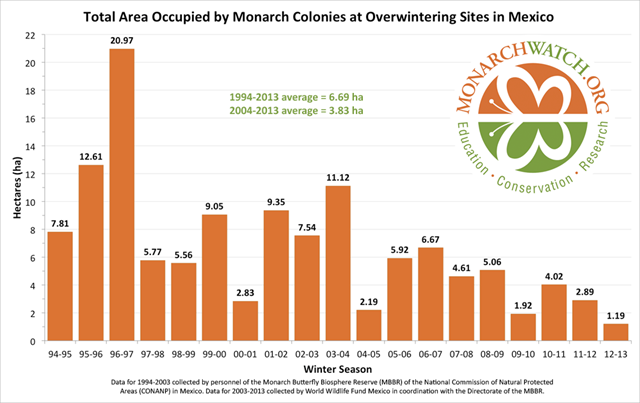Graph of the Day: Total area occupied by Monarch butterfly colonies at overwintering sites in Mexico, 1994-2013
By Chip Taylor
14 March 2013 (Monarch Watch) – The World Wildlife Fund-Mexico / Telcel Alliance, in collaboration with Mexico’s National Commission of Natural Protected Areas (CONANP), held a press conference late on the 13th of March 2013 to announce the results of the status of the monarch populations that overwinter in the oyamel forests of Mexico. Measures of the areas occupied by each of the nine monarch colonies in the states of Michoacan and Mexico totaled 1.19 hectares. This number represents a decline of almost 59% from the area occupied the previous winter. Further, this population is the smallest recorded since the monarch colonies came to the attention of scientists in 1975. A visual inspection of Figure 1 reveals a clear downward trend in the population. This decline is statistically significant* (analysis by Ernest Williams, Hamilton College): linear regression: p=0.004, R squared = 0.402
exponential regression: p=0.001, R squared = 0.477 At issue is the cause of the decline and there are a number of factors involved: 1) The loss of milkweeds in row crops (corn and soybeans) due to the adoption of seed varieties genetically modified to tolerate treatment with herbicides. The utilization of these herbicide tolerant crops has all but eliminated milkweeds from these fields. 2) The push for the production of biofuels, which has resulted in the planting of 25.5 million more acres of corn and soybeans than were planted as recently as 2006. This increase has been at the expense of milkweed-containing Conservation Reserve Program land, grassland, and rangeland (as well as other crops). 3) Development, which consumes 6000 acres at day or 2.2 million acres a year. 4) Intensive farming that reduces the area from the edge of the road to the field and management of our roadsides with the use of herbicides (and excessive mowing) which also eliminates milkweeds. 5) Deforestation of the oyamel fir forests – although this has declined over the last few years, the condition of these forests is less than optimal for the survival of overwintering monarchs. 6) Unusual weather – and we had plenty of that during the 2012 monarch breeding season. March was the warmest recorded since nationwide record keeping began in 1895. Warm weather tends allow returning monarchs to spread north rapidly and arrivals of monarchs in areas north of Oklahoma in April are often followed by low temperatures that delay development of the population. In 2012, first generation monarchs moving north-northeast out of Texas arrived much earlier in the northern breeding areas than previously recorded. Historically, low overwintering numbers have followed the early arrival of monarchs. These early establishments were followed by one of the hottest and driest summers in recent decades. Hot and dry conditions probably have the effect of reducing adult lifespan and therefore the number of eggs laid per female over their lifetime. All in all, it was not a good year for monarchs. While some of the present decline can certainly be attributed to the seasonal conditions last summer, it is the decline of monarch habitats in the United States and Mexico that is the major concern. The good news is that we can do something about the habitats in the United States and Canada – we can plant milkweed. That said, in order to compensate for the continued loss of habitat we need to plant LOTS AND LOTS of milkweed. To assure a future for monarchs, conservation and restoration of milkweeds needs to become a national priority. Chip Taylor
Director, Monarch Watch * p values indicate the probability of the outcome being due to chance alone. P values of less than 0.01 are considered to be extremely low. R squared represents the relationship between two variables. R square values range from 0-1. High values indicate that two variable are highly correlated.
